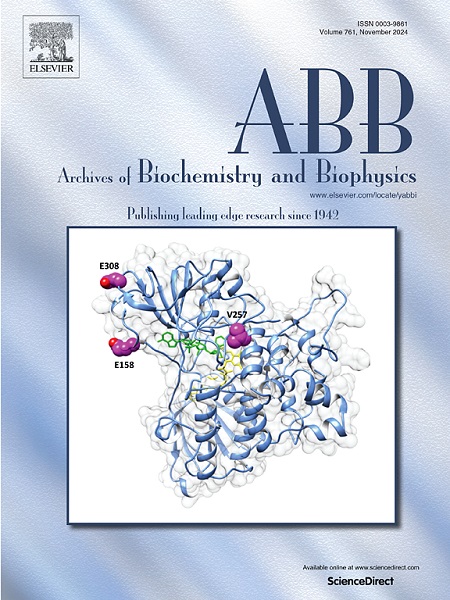蛋白二硫异构酶在介导磺胺二甲基嘧啶诱导的 HT22 细胞铁变态反应中的作用:PDI-NOS-NO-ROS/Lipid-ROS 级联。
IF 3.8
3区 生物学
Q2 BIOCHEMISTRY & MOLECULAR BIOLOGY
引用次数: 0
摘要
铁下垂是一种由过度脂质过氧化引起的细胞死亡。磺胺硫氮嗪(Sulfasalazine, SAS)是一种抗炎药物,通过抑制Xc-系统,引发谷胱甘肽耗竭而诱导铁下垂。近年来,由于其作为抗癌剂的潜力,SAS引起了相当大的兴趣。我们最近的研究表明,蛋白质二硫异构酶(PDI)是化学诱导铁死亡的上游介质,通过催化培养的HT22海马神经元细胞中一氧化氮合酶(NOS)的二聚化和NO的积累。本研究旨在探讨sas诱导HT22细胞的铁沉细胞死亡,重点探讨PDI在介导sas诱导的铁沉中的作用。我们发现,SAS诱导HT22细胞的铁致细胞死亡,并伴随着细胞NO、ROS和脂质ROS积累的时间依赖性顺序增加。我们发现用SAS处理HT22细胞可以激活pdi介导的iNOS激活(二聚化)和NO积累。此外,SAS还能显著上调HT22细胞中的iNOS蛋白水平。PDI敲低或药理抑制PDI活性均可抑制sas诱导的iNOS二聚化,这与消除sas诱导的NO、ROS和脂质ROS的积累有关,并对铁致细胞死亡具有强大的保护作用。另一方面,通过使用TrxR1抑制剂激活PDI可以使细胞对sas诱导的铁下垂强烈敏感。综上所述,这些实验结果表明PDI通过激活PDI→NOS→NO→ROS/脂质-ROS通路,在sas诱导的细胞培养模型中起着至关重要的作用。从这项研究中获得的见解也提供了有效的策略来选择性地使人类癌细胞对sas诱导的铁凋亡敏感,例如通过使用no释放剂或TrxR1抑制剂。本文章由计算机程序翻译,如有差异,请以英文原文为准。

Role of protein disulfide isomerase in mediating sulfasalazine-induced ferroptosis in HT22 cells: The PDI−NOS–NO−ROS/lipid-ROS cascade
Ferroptosis is a form of regulated cell death resulting from excessive lipid peroxidation. Sulfasalazine (SAS), an anti-inflammatory drug, can induce ferroptosis through inhibiting the system Xc− and triggering glutathione depletion. SAS has attracted considerable interest in recent years because of its potential for repurposing as an anticancer agent. Our recent studies have shown that protein disulfide isomerase (PDI) is an upstream mediator of chemically-induced ferroptosis through catalyzing the dimerization of nitric oxide synthase (NOS) and NO accumulation in cultured HT22 hippocampal neuronal cells. The present study aims to investigate SAS-induced ferroptotic cell death in HT22 cells with a focus on determining the role of PDI in mediating SAS-induced ferroptosis. We find that SAS induces ferroptotic cell death in HT22 cells, which is accompanied by a time-dependent sequential increase in the accumulation of cellular NO, ROS and lipid-ROS. We find that treatment of HT22 cells with SAS activates PDI-mediated iNOS activation (dimerization) and NO accumulation. In addition, SAS also strongly upregulates iNOS protein levels in HT22 cells. PDI knockdown or pharmacological inhibition of PDI's activity each suppresses SAS-induced iNOS dimerization, which is associated with abrogation of SAS-induced accumulation of NO, ROS and lipid-ROS, and a strong protection against ferroptotic cell death. On the other hand, PDI activation through the use of a TrxR1 inhibitor can strongly sensitize cells to SAS-induced ferroptosis. Together, these experimental observations demonstrate a crucial role of PDI in SAS-induced ferroptosis in a cell culture model through the activation of the PDI → NOS → NO → ROS/lipid-ROS pathway. Insights gained from this study also provide effective strategies to selectively sensitizing human cancer cells to SAS-induced ferroptosis, such as through the use of NO-releasing agents or TrxR1 inhibitors.
求助全文
通过发布文献求助,成功后即可免费获取论文全文。
去求助
来源期刊

Archives of biochemistry and biophysics
生物-生化与分子生物学
CiteScore
7.40
自引率
0.00%
发文量
245
审稿时长
26 days
期刊介绍:
Archives of Biochemistry and Biophysics publishes quality original articles and reviews in the developing areas of biochemistry and biophysics.
Research Areas Include:
• Enzyme and protein structure, function, regulation. Folding, turnover, and post-translational processing
• Biological oxidations, free radical reactions, redox signaling, oxygenases, P450 reactions
• Signal transduction, receptors, membrane transport, intracellular signals. Cellular and integrated metabolism.
 求助内容:
求助内容: 应助结果提醒方式:
应助结果提醒方式:


